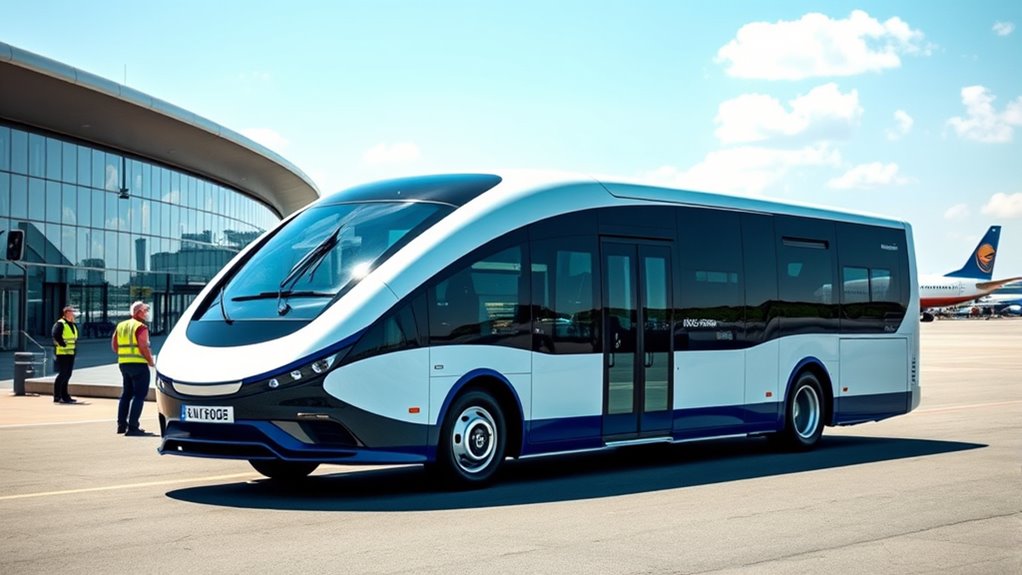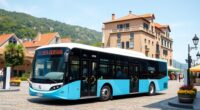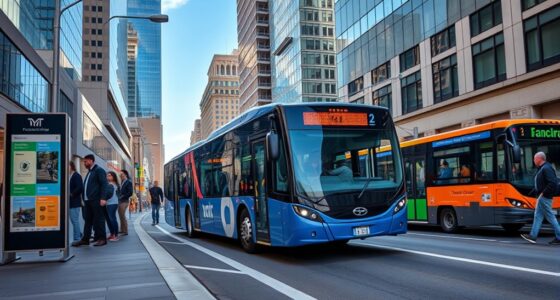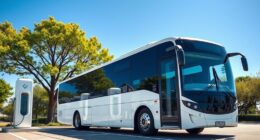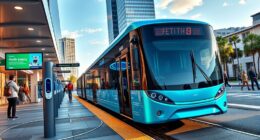Electric buses are transforming airport ground transport by cutting emissions and boosting efficiency. Heathrow’s investment in these vehicles and fast-charging infrastructure reduces reliance on diesel, improves air quality, and supports sustainability goals. Their quiet operation benefits staff and passengers alike. As Heathrow expands its electric fleet, it sets a leading example for airports worldwide. If you want to explore how these innovations are shaping the future of airport transportation, keep exploring the latest developments.
Key Takeaways
- Electric buses at Heathrow reduce emissions, improving air quality and supporting sustainability goals.
- Robust fast-charging infrastructure ensures operational efficiency and minimizes bus downtime.
- Transition enhances passenger experience with quieter, cleaner ground transportation options.
- Infrastructure scalability allows Heathrow to expand its electric fleet seamlessly in the future.
- Heathrow’s adoption of electric buses sets a global example for sustainable airport ground transport.

Have you ever considered how electric buses are transforming airport ground transportation? At Heathrow, this shift is more than just an upgrade in vehicles; it’s a strategic move toward creating a more sustainable and efficient hub. One of the key elements enabling this transformation is the development of robust charging infrastructure. Without a reliable network of charging stations, electric buses can’t operate seamlessly, which is why Heathrow has invested heavily in installing fast chargers at strategic points throughout the airport. These chargers ensure that buses can quickly recharge during short layovers, minimizing downtime and maximizing operational efficiency. As a result, electric buses can be deployed more frequently, reducing reliance on traditional diesel-powered vehicles and helping streamline ground operations.
The impact of this transition extends well beyond operational convenience. By replacing diesel-powered buses with electric ones, Heathrow is actively working toward emission reduction. Electric buses produce zero tailpipe emissions, which substantially cuts down on air pollutants like nitrogen oxides and particulate matter—common issues around busy airports. This shift not only benefits the environment but also enhances air quality within the airport grounds, improving the health and comfort of staff, passengers, and nearby communities. Furthermore, as electric buses operate more quietly than their diesel counterparts, noise pollution is also reduced, creating a more pleasant environment for everyone on site.
Implementing electric buses at Heathrow also aligns with broader efforts to meet sustainability goals and comply with stricter environmental regulations. The airport’s investment in charging infrastructure demonstrates a forward-thinking approach, guaranteeing the necessary foundation is in place for continued expansion of electric fleet capabilities. This infrastructure also offers scalability, allowing Heathrow to add more electric vehicles in the future without major disruptions. As technology advances, charging becomes faster and more efficient, further boosting the benefits of electric buses.
In essence, the integration of electric buses at Heathrow is a clear example of how charging infrastructure and emission reduction strategies go hand in hand. They form a crucial part of the airport’s commitment to sustainability, operational excellence, and passenger experience. By focusing on these elements, Heathrow is setting a precedent for other airports worldwide, illustrating how electric ground transport can be a practical, impactful solution to modern environmental and operational challenges. The move toward electric buses is not just about cleaner air; it’s about reimagining airport transportation as a more responsible, efficient, and future-ready system.
Recent advancements in AI security also support the development of smarter, more reliable charging networks, ensuring safety and efficiency in day-to-day operations.
Frequently Asked Questions
How Do Electric Buses Handle Extreme Weather Conditions?
Electric buses handle extreme weather conditions fairly well, thanks to enhanced battery performance and weather resilience. You’ll find that cold temperatures may slightly reduce battery efficiency, but modern thermal management systems keep batteries functioning ideally. In hot weather, cooling systems prevent overheating, ensuring consistent performance. Overall, these improvements help electric buses operate reliably year-round, even in harsh climates, providing dependable ground transport regardless of weather challenges.
What Is the Lifespan of an Electric Bus Compared to Diesel Models?
Compared to diesel models, electric buses typically have a longer lifespan, often around 15-20 years, mainly due to fewer moving parts and lower wear and tear. For example, Heathrow’s electric buses benefit from advanced battery longevity and optimized maintenance schedules, allowing them to stay in service longer. Diesel buses might last a similar or slightly shorter time, but electric models tend to require less intensive maintenance, extending their effective operational life.
How Are Charging Stations Integrated Into Airport Infrastructure?
You integrate charging stations into airport infrastructure by designing them with efficient charging station design, ensuring they fit seamlessly into existing facilities. You also focus on power grid integration, which involves connecting stations to the local grid to manage energy flow effectively. This way, electric buses can charge quickly and reliably, minimizing downtime and supporting smooth airport operations. Proper integration enhances sustainability and operational efficiency at the airport.
What Are the Costs Associated With Transitioning to Electric Buses?
You’ll need to do a thorough cost analysis to understand the expenses involved in switching to electric buses. The main costs include infrastructure investment for charging stations, bus procurement, and training staff. While upfront costs are significant, they can be offset by lower operating and maintenance expenses over time. Planning carefully helps you balance initial investments with long-term savings, ensuring a smooth and cost-effective changeover to electric ground transport.
How Do Electric Buses Impact Airport Noise Levels?
Imagine fewer honks and engine roars echoing through the airport. Electric buses dramatically cut noise levels, making your arrival more peaceful. This noise reduction benefits community health, reducing stress and improving sleep for nearby residents. So, by switching to electric, you help create a calmer environment, proving that quieter buses aren’t just a luxury—they’re a smart move for everyone’s well-being and the local community’s peace of mind.
Conclusion
As you can see, electric buses are transforming airport ground transport. At Heathrow, they’ve reduced emissions by over 30% since adoption, showcasing their environmental impact. This shift not only helps cut air pollution but also improves passenger experience with quieter, smoother rides. Embracing electric buses proves you’re committed to sustainability, making airports like Heathrow leaders in eco-friendly travel. Clearly, investing in electric ground transport isn’t just good for the planet—it’s a smart move for future airport operations.
